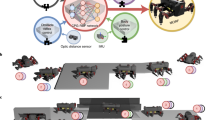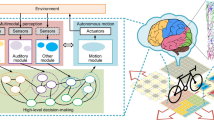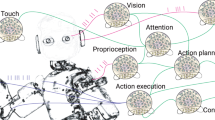Abstract
Controlling sensori-motor systems in higher animals or complex robots is a challenging combinatorial problem, because many sensory signals need to be simultaneously coordinated into a broad behavioural spectrum. To rapidly interact with the environment, this control needs to be fast and adaptive. Present robotic solutions operate with limited autonomy and are mostly restricted to few behavioural patterns. Here we introduce chaos control as a new strategy to generate complex behaviour of an autonomous robot. In the presented system, 18 sensors drive 18 motors by means of a simple neural control circuit, thereby generating 11 basic behavioural patterns (for example, orienting, taxis, self-protection and various gaits) and their combinations. The control signal quickly and reversibly adapts to new situations and also enables learning and synaptic long-term storage of behaviourally useful motor responses. Thus, such neural control provides a powerful yet simple way to self-organize versatile behaviours in autonomous agents with many degrees of freedom.
This is a preview of subscription content, access via your institution
Access options
Subscribe to this journal
Receive 12 print issues and online access
$209.00 per year
only $17.42 per issue
Buy this article
- Purchase on Springer Link
- Instant access to full article PDF
Prices may be subject to local taxes which are calculated during checkout




Similar content being viewed by others
References
Bernstein, N. A. The Coordination and Regulation of Movements (Pergamon, 1967).
Grillner, S. Biological pattern generation: The cellular and computational logic of networks in motion. Neuron 52, 751–766 (2006).
Büschges, A. Sensory control and organization of neural networks mediating coordination of multisegmental organs for locomotion. J. Neurophysiol. 93, 1127–1135 (2005).
Pearson, K. G. & Franklin, R. Characteristics of leg movements and patterns of coordination in locusts walking on rough terrain. Int. J. Robot. Res. 3, 101–112 (1984).
Ijspeert, A. J. Central pattern generators for locomotion control in animals and robots: A review. Neural Netw. 21, 642–653 (2008).
Brooks, R. A. A robust layered control systems for a mobile robot. IEEE Trans. Robot. Autom. 2, 14–23 (1986).
Kurazume, R., Yoneda, K. & Hirose, S. Feedforward and feedback dynamic trot gait control for quadruped walking vehicle. Auton. Robots 12, 157–172 (2002).
Shkolnik, A. & Tedrake, R. Proc. IEEE Int. Conf. on Robotics and Automation 4331–4336 (IEEE Press, 2007).
Ijspeert, A. J., Crespi, A., Ryczko, D. & Cabelguen, J. M. From swimming to walking with a salamander robot driven by a spinal cord model. Science 315, 1416–1420 (2007).
Kimura, H., Fukuoka, Y. & Cohen, A. H. Adaptive dynamic walking of a quadruped robot on natural ground based on biological concepts. Int. J. Robot. Res. 26, 475–490 (2007).
Collins, J. J. & Richmond, S. A. Hard-wired central pattern generators for quadrupedal locomotion. Biol. Cybern. 71, 375–385 (1994).
Ayers, J. & Witting, J. Biomimetic approaches to the control of underwater walking machines. Phil. Trans. R. Soc. A 365, 273–295 (2007).
Ishiguro, A., Fujii, A. & Eggenberger Hotz, P. Neuromodulated control of bipedal locomotion using a polymorphic CPG circuit. Adapt. Behav. 11, 7–17 (2003).
Kuniyoshi, Y. & Sangawa, S. Early motor development from partially ordered neural-body dynamics: Experiments with a cortico-spinal-musculo-skeletal model. Biol. Cybern. 95, 589–605 (2006).
Buchli, J., Righetti, L. & Ijspeert, A. J. Engineering entrainment and adaptation in limit cycle systems—from biological inspiration to applications in robotics. Biol. Cybern. 95, 645–664 (2006).
Arena, P., Fortuna, L., Frasca, M. & Sicurella, G. An adaptive, self-organizing dynamical system for hierarchical control of bio-inspired locomotion. IEEE Trans. Syst. Man Cybern. B 34, 1823–1837 (2004).
Rabinovich, M. I. & Abarbanel, H. D. I. The role of chaos in neural systems. Neuroscience 87, 5–14 (1998).
Wilson, D. M. Insect walking. Annu. Rev. Entomol. 11, 103–122 (1966).
Manoonpong, P., Pasemann, F. & Wörgötter, F. Sensor-driven neural control for omnidirectional locomotion and versatile reactive behaviours of walking machines. Robot. Auton. Syst. 56, 265–288 (2008).
Orlovsky, G. N., Deliagina, T. G. & Grillner, S. Neuronal Control of Locomotion: From Mollusk to Man (Oxford Univ. Press, 1999).
Ott, E., Grebogi, C. & Yorke, J. A. Controlling chaos. Phys. Rev. Lett. 64, 1196–1199 (1990).
Schmelcher, P. & Diakonos, F. K. General approach to the localization of unstable periodic orbits in chaotic systems. Phys. Rev. E 57, 2739–2746 (1998).
Schöll, E. & Schuster, H.G. Handbook of Chaos Control (Wiley–VCH, 2007).
Schuster, H. G. Deterministic Chaos. An Introduction (Wiley–VCH, 2005).
Schimansky-Geier, L., Fiedler, B., Kurths, J. & Schöll, E. Analysis and Control of Complex Nonlinear Processes in Physics, Chemistry and Biology (World Scientific, 2007).
Pasemann, F. Complex dynamics and the structure of small neural networks. Network 13, 195–216 (2002).
van Vreeswijk, C. & Sompolinsky, H. Chaos in neuronal networks with balanced excitatory and inhibitory activity. Science 274, 1724–1726 (1996).
Brunel, N. Dynamics of sparsely connected networks of excitatory and inhibitory spiking neurons. J. Comput. Neurosci. 8, 183–208 (2000).
Zillmer, R., Brunel, N. & Hansel, D. Very long transients, irregular firing, and chaotic dynamics in networks of randomly connected inhibitory integrate-and-fire neurons. Phys. Rev. E 79, 031909 (2009).
Jahnke, S., Memmesheimer, R.-M. & Timme, M. Stable irregular dynamics in complex neural networks. Phys. Rev. Lett. 100, 048102 (2008).
Jahnke, S., Memmesheimer, R.-M. & Timme, M. How chaotic is the balanced state? Front. Comput. Neurosci. 3, 13 (2009).
Hoyt, D. F. & Taylor, C. R. Gaits and the energetics of locomotion in horses. Nature 292, 239–240 (1981).
Srinivasan, M. & Ruina, A. Computer optimization of a minimal biped model discovers walking and running. Nature 439, 72–75 (2006).
Delcomyn, F. Walking robots and the central and peripheral control of locomotion in insects. Auton. Robots 7, 259–270 (1999).
Klaassen, B., Linnemann, R., Spenneberg, D. & Kirchner, F. Biomimetic walking robot SCORPION: Control and modelling. Robot. Auton. Syst. 41, 69–76 (2002).
Asa, K., Ishimura, K. & Wada, M. Behavior transition between biped and quadruped walking by using bifurcation. Robot. Auton. Syst. 57, 155–160 (2009).
Pearson, K. G. & Iles, J. F. Nervous mechanisms underlying intersegmental coordination of leg movements during walking in the cockroach. J. Exp. Biol. 58, 725–744 (1973).
Gabriel, J. P. & Büschges, A. Control of stepping velocity in a single insect leg during walking. Phil. Trans. R. Soc. A 365, 251–271 (2007).
Pfeifer, R., Lungarella, M. & Iida, F. Self-organization, embodiment, and biologically inspired robotics. Science 318, 1088–1093 (2007).
Beer, R. D., Quinn, R. D., Chiel, H. J. & Ritzmann, R. E. Biologically inspired approaches to robotics. Commun. ACM 40, 30–38 (1997).
Korn, H. & Faure, P. Is there chaos in the brain? II. Experimental evidence and related models. C. R. Biol. 326, 787–840 (2003).
Iida, F. & Pfeifer, R. Sensing through body dynamics. Robot. Auton. Syst. 54, 631–640 (2006).
Pitti, A., Lungarella, M. & Kuniyoshi, Y. Exploration of natural dynamics through resonance and chaos. Proc. 9th Conf. on Intelligent Autonomous Systems 558–565 (IOS Press, 2006).
Wehner, R. Desert ant navigation: How miniature brains solve complex tasks. J. Comput. Physiol. A 189, 579–588 (2003).
McVea, D. A. & Pearson, K. G. Long-lasting memories of obstacles guide leg movements in the walking cat. J. Neurosci. 26, 1175–1178 (2007).
Manoonpong, P., Pasemann, F. & Roth, H. Modular reactive neurocontrol for biologically-inspired walking machines. Int. J. Robot. Res. 26, 301–331 (2007).
Widrow, B. & Hoff, M. E. Adaptive switching circuit. IRE WESCON Conv. Rec. 4, 96–104 (1960).
Acknowledgements
We thank F. Pasemann, T. Geisel, A. Büschges and A. J. Ijspeert for fruitful discussions and acknowledge financial support by the Ministry for Education and Science (BMBF), Germany, through the Bernstein Center for Computational Neuroscience, grant numbers 01GQ0432 (F.W.) and 01GQ0430 (M.T.) as well as by the Max Planck Society (M.T.). F.W. acknowledges financial support by the European Commission ‘PACO-PLUS’.
Author information
Authors and Affiliations
Contributions
All authors conceived and designed the experiments, contributed materials and analysis tools and analysed the data. S.St. carried out the numerical experiments. P.M. developed the robotic system. P.M. and S.St. carried out the robotic experiments. M.T., F.W. and S.St. worked out the theory. M.T. and F.W. supervised the numerical and robotic experiments. M.T., F.W. and P.M. wrote the manuscript.
Corresponding author
Ethics declarations
Competing interests
The authors declare no competing financial interests.
Supplementary information
Supplementary Information
Supplementary Information (PDF 1097 kb)
Supplementary Movie
Supplementary Movie 1 (MPG 9832 kb)
Supplementary Movie
Supplementary Movie 2 (MPG 23572 kb)
Supplementary Movie
Supplementary Movie 3 (MPG 13139 kb)
Supplementary Movie
Supplementary Movie 4 (MPG 20444 kb)
Supplementary Movie
Supplementary Movie 5 (MPG 42928 kb)
Supplementary Movie
Supplementary Movie 6 (MPG 15003 kb)
Rights and permissions
About this article
Cite this article
Steingrube, S., Timme, M., Wörgötter, F. et al. Self-organized adaptation of a simple neural circuit enables complex robot behaviour. Nature Phys 6, 224–230 (2010). https://doi.org/10.1038/nphys1508
Received:
Accepted:
Published:
Issue Date:
DOI: https://doi.org/10.1038/nphys1508
This article is cited by
-
Chaotic Dynamics in a Class of Delay Controlled Partial Difference Equations
Journal of Dynamical and Control Systems (2024)
-
Controllable branching of robust response patterns in nonlinear mechanical resonators
Nature Communications (2023)
-
AI Pontryagin or how artificial neural networks learn to control dynamical systems
Nature Communications (2022)
-
Versatile modular neural locomotion control with fast learning
Nature Machine Intelligence (2022)
-
Bio-Inspired Modular Relative Jacobian for Holistically Controlled Four-Arm Manipulators Using Opposite and Adjacent Dual-Arm Pairs
Arabian Journal for Science and Engineering (2022)



